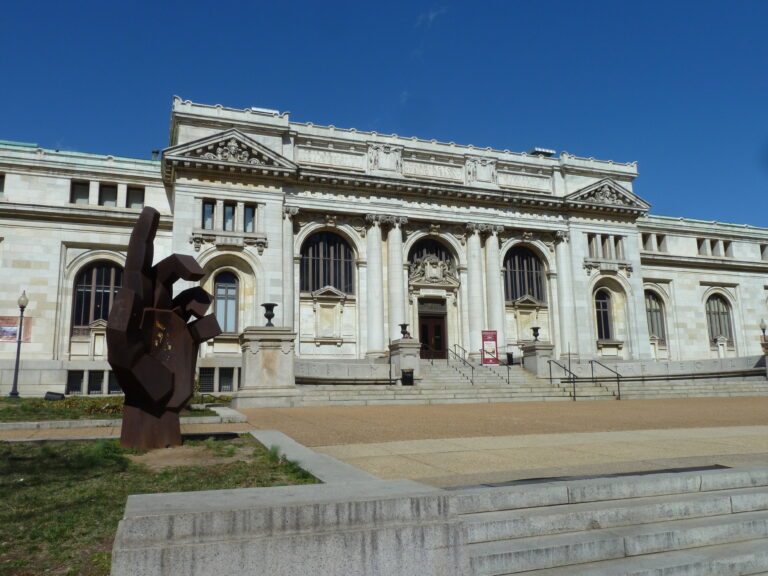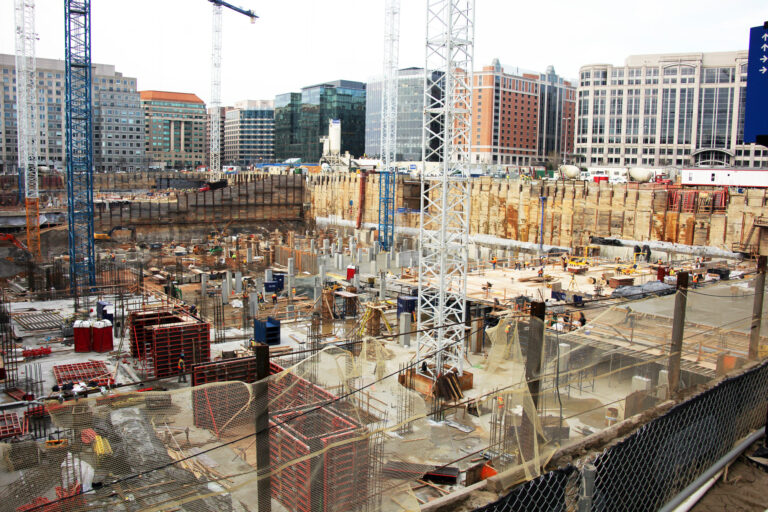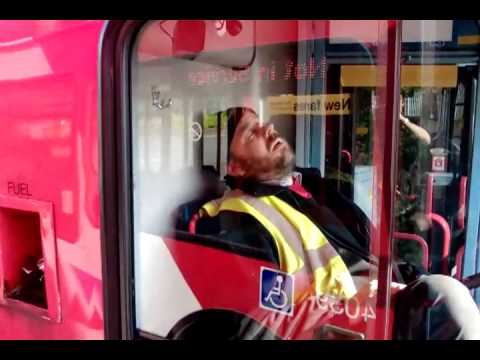Physical Address
304 North Cardinal St.
Dorchester Center, MA 02124
Physical Address
304 North Cardinal St.
Dorchester Center, MA 02124

The Carnegie Library in Washington, D.C. is now home to the world’s newest Apple Store following an expensive rehabilitation funded by the retailer. Originally built as a public library in 1903, it reopened its doors to the public on May 11, 2019 following decades of disuse, neglect, and a slew of failed attempts to repurpose the building as a museum. While some are fretting that a historic building owned by the city has been turned over to commercial use, we can rest assured that the Historical Society of Washington, D.C., the current leaseholder to the building, made the right decision. More than fifteen years ago, Niskanen Center founder Jerry Taylor and his then-colleague at the Cato Institute, Peter Van Doren, had a novel proposal to solve an intractable political dispute about the Arctic National Wildlife Refuge (ANWR), a wilderness area in northeast Alaska that is home to large populations of wildlife and vast, untapped petroleum deposits. In the early 2000s, the Bush Administration proposed opening the refuge to oil drilling in the wake of rising crude oil prices. Naturally, the usual suspects came out in favor or against the proposal. Environmentalist detractors worried that a pristine wildlife area could be ruined by any drilling and the possibility of leaky pipelines. Advocates, on the other hand, claimed only a tiny sliver of land was needed to extract billions of dollars of oil and the refuge would remain largely untouched. The benefits of oil drilling, proponents argued, would be widely shared because oil is used in so many parts of economy. Taylor and Van Doren’s proposal was simple: the federal government should give ANWR, in its entirety, to the Sierra Club or some other environmentalist group, including full rights to use or transfer the land as they see fit. While the Sierra […]

During his last days in office, former Representative Jason Chaffetz must have forgotten he is supposed to be a fiscal conservative. His recent comments that members of Congress need $2,500 stipends to afford housing in DC reflect a complete ignorance of both the reasons for high housing prices and the best ways to lower those prices. Instead of treating the symptoms of skyrocketing housing prices, policymakers should be striking at the root: rent control, height limits, and burdensome zoning restrictions that discourage development. All of this turns on basic economics. Markets drive prices of goods and services down, but only if they are competitive. In many cases, existing interests try to prevent others from entering markets in order to protect their own bottom lines. Zoning regulations are often manipulated by interest groups, who hope to limit the allowed uses of land within a city and prevent future developments. Zoning essentially fixes the amount of available housing by discouraging developers from building more housing, ultimately driving housing prices up. Academic research places much of the blame for high housing costs on zoning––and this isn’t just limited to a single city or state. Edward Glaeser and Raven Saks of Harvard and Joseph Gyourko of the University of Pennsylvania examined Manhattan’s housing market estimate that new construction costs for housing are only about $300 per square foot, but that square foot tends to be rented out for $600, twice the cost at construction. Glaeser, Gyourko, and Saks write, quite intuitively, that “this would seem to offer an irresistible opportunity for developers.” But it’s zoning regulations that prevent developers from coming in to build more homes (which ultimately lowers housing prices), despite market incentives. Even though there is a deafening clamor for more housing, as evidenced by rising prices, building takes so long in […]

Over at Greater Greater Washington, Ms. Cheryl Cort attempts to temper expectations of what she calls the “libertarian view (a more right-leaning view in our region)” on affordable housing. It is certainly reassuring to see the cosmopolitan left and the pro-market right begin to warm to the benefits of liberalization of land-use. Land-use is one area the “right,” in it’s fear of change, has failed to embrace a widespread pro-market stance. Meanwhile, many urban-dwellers who consider themselves on the “left” unknowingly display an anti-outsider mentality typically attributed to the right’s stance on immigration. Unfortunately, in failing to grasp the enormity of the bipartisan-caused distortion of the housing market, Ms. Cort resigns to advocate solutions that fail to deliver widespread housing affordability. Yes, adding more housing must absolutely be a part of the strategy to make housing more affordable. And zoning changes to allow people to build taller and more usable space near transit, rent out carriage houses, and avoid expensive and often-unnecessary parking are all steps in the right direction. But some proponents go on to say relaxing zoning will solve the problem all on its own. It won’t. Well, if “relaxing” zoning is the solution at hand, she may be right – relaxing will only help a tad… While keenly aware of the high prices many are willing to pay, Cort does not seem to grasp the incredible degree to which development is inhibited by zoning. “Relaxing” won’t do the trick in a city where prices are high enough to justify skyscrapers with four to ten times the density currently allowed. When considering a supply cap that only allows a fraction of what the market demands, one can not reasonably conclude “Unlimited FAR” (building density) would merely result in a bit more development here and there. A radically liberalized land-use regime would […]
There are two general attitudes among urbanists towards the transportation omnibus bill that Congress has been struggling to pass in recent years (?). Some, like Streetsblogs and a number of political advocacy groups, hope for swift passage because of the bill’s transit spending. Others, like Cap’n Transit, balk at all the highway spending, and cheer on the gridlock. And here’s one other reason to be on Cap’n Transit’s side: no new bill means no federal regulation of rapid transit. Right now, the federal government only has the power to regulate safety on rail lines that feed into the national mainline network, and could therefore, at least in theory, run into a freight train. This includes all intercity trains (Amtrak and possibly All Aboard Florida), commuter trains (Metro-North, Caltrain, etc.), and the occasional light rail line using an older right-of-way that’s still connected to the national network (e.g., New Jersey’s River Line). Self-contained “rapid transit” networks – subways, elevated trains, and new light rail and streetcar lines – are beyond the feds’ reach. To many legislators, the Fort Totten crash on DC’s Red Line in 2009, operated by WMATA, was evidence that federal regulation is needed. (WMATA’s MetroRail is actually one of the most technologically advanced systems in America – or at least it was, until after the crash when they turned the ATO off, which drives the train while the operator opens and closes the doors.) There was a big outcry about it right after the crash and a few times since then, and the debate seems to be coming up again. But despite the liberal leanings of most transit enthusiasts, you’d be hard pressed to find one who thinks that federal regulation will do WMATA – an admittedly heinous agency that needs to be reined in – any good. […]
Not sure how this escaped me, but it seems that a few weeks ago, Rollin Stanley was announced as Calgary’s new chief planner. Rollin Stanley, you’ll recall, was the very vocal pro-urban growth planner in Maryland’s Montgomery County, north of Washington, DC, who resigned after these four sentences appeared in Bethesda Magazine: He has little patience with dissenters. Stanley goes so far as to accuse them of being “rich, white women…spreading fear.” He says they stalk his appearances before community groups, sowing discord. He claims they refer to themselves as “the coven.” Most Americans still don’t think of Calgary as a very urban place, but it’s been holding its own against Vancouver and Toronto lately when it comes to urbanism in Canada (which is generally much more advanced than urbanism in the US), even without true rapid transit (the C-Train, while impressive as light rail, still has to cross streets). Calgary’s skyline’s been booming, and as the Calgary Herald writes, the city also has an urbanist mayor: Stanley’s approach somewhat resembles that of Mayor Naheed Nenshi, and beyond his unconventionally frank yet also high-reaching rhetoric. Nenshi, too, deplores suburban sprawl and the financial challenges it brings for government, and praises more walkable districts and transit. While Nenshi avidly uses social-media site Twitter, Stanley blogs prolifically with long rhapsodies on everything from master plans and neighbourhood walkabouts to census data and criticism. Here’s his old Montgomery County blog – does anyone know if he’s keeping one in Calgary? Or if maybe we could lure him to Twitter? There appears to be a general political consensus – that thing Alon Levy’s always talking about – towards urbanism in Calgary, so Calgary will likely get good urbanism: While the developer sector in Calgary is well-organized, there’s not as professionalized and unified community movement against […]
Over at Washington City Paper‘s Housing Complex blog, Lydia DePillis takes issue with DC’s car sharing policy – and namely, the decision to auction off on-street spaces to the highest (car-sharing) bidder, “rather than allow the market’s first mover—Zipcar—[to] have them all for free.” She writes: The bigger question, it seems to me, is whether we need competition at all. The inaugural auction led to Zipcar losing 80 percent of its curbside parking spaces.

Since Alon’s comment a few weeks ago that union work rules, not wages and benefits, are the real problem with labor unions at America’s transit authorities, I’ve been looking into the matter, which seems to be something that a lot of transit boosters don’t like to talk about. It’s an uncomfortable subject for two reason: 1) urban planners and unions have an ideological affinity, and 2) it’s hard to lobby for increased subsidies for transit when you admit that you’re making poor use of the money you already have. But despite planners’ reticence to talk about the problem, it needs to be addressed. Throwing money around is what governments do best, and while it might be an easy solution to problems in the short run, the money is running out. Some will surely quibble that we can afford to raise taxes and do more deficit spending, especially for something as vital as transit, but whether or not that’s true, the fact is that voters are increasingly doubting that it is, and so politicians are going to become stingier about doling out money for transit. Anyway, the most obvious area for savings is in actual wages and benefits, but many mainstream conservative and libertarian publications have written a lot about this issue, so I want to focus on just inefficient work rules. These are rules that are written into union contracts hashed out in a political process, and management doesn’t have the authority to overturn them. I found surprisingly little on the issue in the academic literature, but there’s plenty on it in newspapers, and so here’s a round-up of the major issues that I found with various American transit unions. The list is by no means comprehensive – either of all the cities that have these problems, or even of […]
1. NY Governor Cuomo promises the “most aggressive” strengthening of the state’s (read: NYC’s) rent laws. 2. Bronx <3 parking: “This community wants a moratorium on any more building until we get a parking lot.” “We don’t want any bigger buildings and we want parking space for everyone.” 3. Do people realize that “I don’t mind modernist architecture” and “All new buildings must have decorative cornices and intricate brickwork” are fundamentally incompatible statements? 4. Witold Rybczynski on density. Nothing you haven’t already heard a million times before, but, Witold Rybczynski! 5. DC’s zoning code finally allows building owners to enclose the once-encouraged outdoor arcades.
1. The fact that we even have to have a debate over whether residential development should be allowed in Midtown, where new residents will have perhaps a smaller impact on transportation infrastucture than anywhere else in the country (they can either walk to work or do a reverse train commute), is pretty pathetic. 2. The plan for San Jose’s Diridion Station is is so loaded down with boondoggles and bad ideas that it’s hard to keep track of them all. As if a stadium and HSR station weren’t bad enough it’s also getting a neo-Euclidean zoning plan (business and R&D park to the north, entertainment, retail, and office space by the station, and residential and retail to the south), “adequate parking,” and what looks to me like probably too much parkland. One panelist from the Greenbelt Alliance said it was necessary for the plan to include “parks, trails and public plazas.” But given that it looks like we’re only really talking about an area that’s a dozen or two blocks in size, is all that really necessary? 3. Second Avenue Subway on Bloomberg’s transit failures. Looks like my bike lane rabble-rousing is spreading… 4. More union shenanigans: Unsuck DC Metro uncovers with a FOIA request $2.4 million paid out in the last five years “in grievance back pay for work never done.” Some of it is paid out in petty seniority squabbles, some in more reprehensible cases, including to people who have literally killed, assaulted, and stolen on the job. Also, if you’re interested in how exactly unions suck the lifeblood out of American mass transit, Unsuck’s three–part series on the DC Metro’s escalator problems is an excellent case study. 5. Highway interchange transit-oriented development. Not a joke. Courtesy of the Overhead Wire.
Our friends at BeyondDC have made a nifty little simplified map of the DC zoning code (yellow is residential, red is commercial, gray is park/institutional/industrial) out of GIS data provided by the local government. It’s nice and all, but when you reduce such a beautifully complex and meticulous plan to a mere three colors, you lose all the local flavor that makes DC unique. So, I’ve taken the liberty of mining the GIS data and annotating the map a bit, in an attempt to better present the true spirit of The Zoning Code: …I was tempted to put the “Fine. But only till the black people leave” in a big fat watermark over the entire city, but alas, I made it with Pixlr. DC residents, feel free to leave additional annotations in the comments.